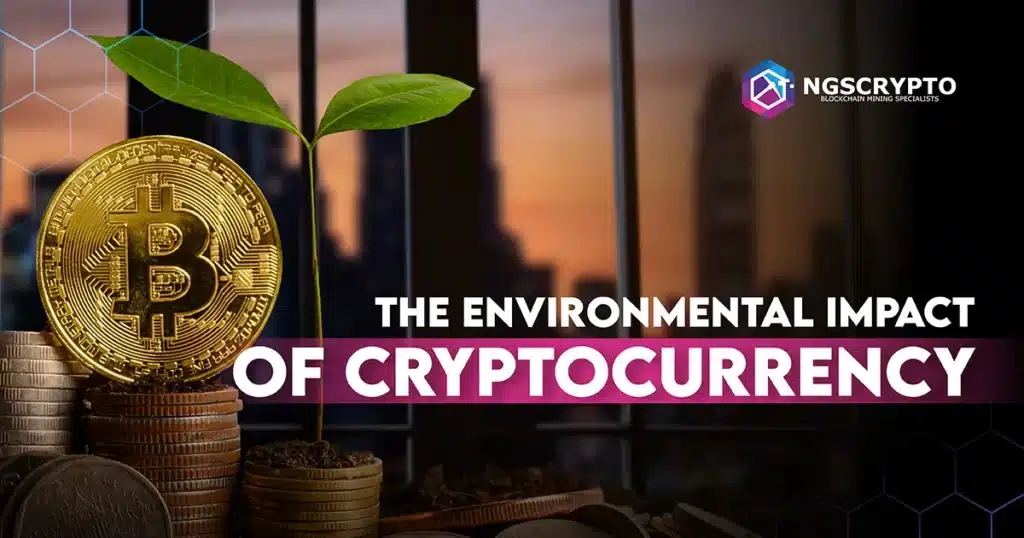NGS Crypto is an Authorised Reseller of NGS Group Blockchain Mining Packages
NGS Crypto is an Authorised Reseller of NGS Group Blockchain Mining Packages


Written by Katya Richardson
Share this article
In recent years, the environmental impact of cryptocurrency mining has gained significant attention, sparking debates and concerns among scientists and activists alike. The heart of this issue lies in the substantial energy consumption required to mine Bitcoin and other cryptocurrencies, raising questions about their carbon footprint. This concern is not just a technicality but a pressing environmental challenge, as the global pursuit of digital currencies intersects with the urgent need for sustainable practices.
In this article, we explore the multifaceted concerns regarding the energy consumption of cryptocurrencies, the ongoing efforts to minimise their environmental impact, and the prospects for the development of eco-friendly cryptocurrencies in the future.
Cryptocurrency is a digital currency secured by complex computer codes. The most well-known is Bitcoin. They operate on a system called blockchain, a digital ledger spread across numerous computers. A major concern with cryptocurrencies in Australia and globally is their high electricity use, particularly for ‘mining’ – computers solving complex problems to maintain the system. This can be environmentally harmful as much of this electricity is generated from fossil fuels, causing pollution.
To gain a better understanding of this process, delve into what is blockchain mining, which explains the fundamentals behind these energy-intensive operations.
Each cryptocurrency operates on a blockchain, which acts like a public digital ledger. This ledger isn’t stored on a single computer but is distributed across numerous computers connected to the internet, known as nodes. These nodes constantly update and share the information.
The process of verifying and recording transactions on this digital ledger is carried out by powerful computers through a method called mining. This process is effective because all participants in the network can see and agree on the information, allowing new data to be added in interconnected blocks, and making it accessible for verification at any time.
However, cryptocurrency mining has a significant environmental impact, primarily due to its high energy consumption:
Cryptocurrencies like Bitcoin aren’t controlled by any central authority, so there’s no single entity to check transactions. Instead, those in the Bitcoin network engage in ‘mining’, a competition to solve complex puzzles that generate more currency. The first to crack the puzzle gets the opportunity to verify transactions and add the latest bunch to the blockchain.
In this ‘proof of work’ (PoW) process, the victor earns new cryptocurrency, but it’s this very method that’s responsible for significant greenhouse gas emissions. The PoW algorithm needed to validate transactions demands huge amounts of electricity, often sourced from burning fossil fuels. This leads to carbon dioxide and other greenhouse gases being released, contributing to global warming.
For detailed insights on Bitcoin’s specific energy demands, read how bitcoin mining works.

A 2022 study named ‘Revisiting Bitcoin’s Carbon Footprint’, conducted by climate and economic researchers in Europe, suggests that Bitcoin mining could produce about 65.4 megatonnes of CO2 annually, and energy used is estimated between 100 and 1,000 kWh per transaction.
Now, cryptocurrencies use special methods to lower their impact on the environment. These methods can also help other cryptocurrencies become more eco-friendly. Here are some methods that make cryptocurrencies more environmentally friendly:
An immediate and clear response to tackle the carbon emissions from the cryptocurrency sector is shifting to renewable energy sources. In 2021, less than 40% of Bitcoin mining, which relies on the Proof of Work method, was powered by renewable energy. This gap has sparked the rise of several start-ups presenting various solutions.
The Proof-of-Stake (PoS) system asks miners to put forward a small amount of cryptocurrency to enter a lottery for the chance to validate transactions. This reduces the likelihood of them approving dodgy transactions. It also gets rid of the competitive computing aspect seen in Proof-of-Work. For example, Ethereum, which is a major player in the non-fungible token (NFT) market, is planning to cut its energy use by 99.5% by using a new system called Proof-of-Stake (PoS).
Pre-mining is somewhat similar to how fiat money or company shares work: a central body generates a certain amount of cryptocurrency and releases it based on global and business needs. In these systems, transactions are still checked by a network of decentralised miners before being added to the blockchain, but users involved in the transaction might need to pay a small fee for this service.
Using government-issued carbon credits in the cryptocurrency mining industry could encourage companies to buy credits from others, helping to balance out global emissions. Some crypto companies are already investing in carbon credit programs to offset the emissions generated by their activities. This includes purchasing carbon credits or directly funding renewable energy projects.
The future of eco-friendly cryptocurrency is looking up, with a strong focus on environmental friendliness. Emerging technologies, especially Proof-of-Stake (PoS), are making cryptocurrencies less damaging to the environment by reducing their carbon footprint. Government policies around the world are expected to support these eco-friendly practices in the crypto industry.
Interest in green cryptocurrencies is on the rise among crypto enthusiasts and investors. This trend is likely to drive more investments towards environmentally conscious crypto projects, leading to further innovation. Additionally, with improvements in blockchain technology, crypto networks are becoming more energy-efficient. Thus, while the crypto world is indeed waking up to its environmental responsibilities, the journey toward a truly green future is a work in progress.
For those looking to invest in line with these trends, How to invest in cryptocurrency Australia offers practical advice.
The information presented on this website is general information only. It should not be taken as constituting professional advice from the website owner – NGS Crypto PTY LTD (NGS Crypto). Any information regarding past performance and returns contained on this website should not be construed or interpreted as a prediction or opinion as to future performance and returns. NGS Crypto is not a financial adviser. All views and observations expressed by NGS Crypto on this website are for information purposes only, are general in nature and should not be treated as investment or financial advice of any kind.
NGS Crypto is an authorised reseller of NGS Group blockchain mining packages. The information presented on this website (https://ngscrypto.com) is general information only. It should not be taken as constituting professional advice from the website owner – NGS Crypto PTY LTD (NGS Crypto). Any information regarding past performance and returns contained on this website should not be construed or interpreted as a prediction or opinion as to future performance and returns. NGS Crypto is not a financial adviser. All views and observations expressed by NGS Crypto on this website are for information purposes only, are general in nature and should not be treated as investment or financial advice of any kind. Before making an investment in crypto assets, you should consider seeking independent legal, financial, taxation or other such professional advice to check how the information on this website relates to your unique circumstances. NGS Crypto is not liable for any loss caused, whether due to negligence or otherwise arising from the use of, or reliance on, the information provided directly or indirectly, by use of this website. You can view our full terms & conditions by clicking here.
NGS Crypto is not affiliated, associated, authorized, endorsed by, or in any way officially connected with this NGS Super (ABN 73 549 180 515).
© 2024 NGS Crypto
NGS Crypto is an Authorised Reseller of NGS Group
| Cookie | Duration | Description |
|---|---|---|
| cookielawinfo-checkbox-analytics | 11 months | This cookie is set by GDPR Cookie Consent plugin. The cookie is used to store the user consent for the cookies in the category "Analytics". |
| cookielawinfo-checkbox-functional | 11 months | The cookie is set by GDPR cookie consent to record the user consent for the cookies in the category "Functional". |
| cookielawinfo-checkbox-necessary | 11 months | This cookie is set by GDPR Cookie Consent plugin. The cookies is used to store the user consent for the cookies in the category "Necessary". |
| cookielawinfo-checkbox-others | 11 months | This cookie is set by GDPR Cookie Consent plugin. The cookie is used to store the user consent for the cookies in the category "Other. |
| cookielawinfo-checkbox-performance | 11 months | This cookie is set by GDPR Cookie Consent plugin. The cookie is used to store the user consent for the cookies in the category "Performance". |
| viewed_cookie_policy | 11 months | The cookie is set by the GDPR Cookie Consent plugin and is used to store whether or not user has consented to the use of cookies. It does not store any personal data. |